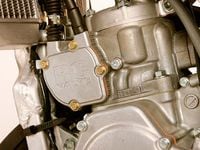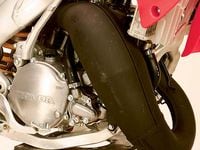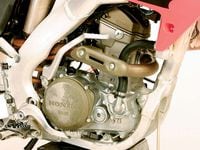Let's face it, the last few years haven't exactly turned out the way I planned, and now I want to redeem myself. I'm tired of riding for teams that don't have good equipment or the commitment to win. Sure, the money has been good, but I'm there to win races and battle with the front-runners. I've spent too much time during the last few years riding nervously because I wasn't sure if my bike would finish a single moto.So when I decided to fund my own team, I wanted to be on the best equipment, period. I knew I could arrange bikes from any manufacturer, but I've always had the most success on Hondas. I rode for the factory team from '93 to '98 and then on my own in 2000 with its support program. Of all the manufacturers, Honda seems to have the best fit and finish on its bikes, and the company holds durability in high regard. I'm a 125-class rider--that's my specialty--and we all can tell that 250cc four-strokes will own the class in the future. So when I heard Honda was building a four-stroke 250, I knew that was the bike I needed to race.When Dirt Rider asked me to do this test, I thought it would be a good opportunity for my 2004 program. I signed my Honda deal without even seeing the bike, so this comparison would give me a chance to compare the new CRF250R with the CR125R. I had already committed to Honda's four-stroke program, but I wanted to see if I had made the right move. If I liked the CR125R better, I figured I could always try to rework my deal.You see, Honda spent a lot of time revamping the entire 125 motor, and it arrived too late to be included in Dirt Rider's 125cc-class MX shootout (Jan. '04). The editors figured it would be interesting to compare the late arrival with the CRF that won the shootout during its inaugural year. It made a lot of sense to me, especially when you take into account that some people are committed to one brand or another and want to know which engine type works better. I know this has really been important to Yamaha riders for the last few years. Yamaha's had four different bikes in the 125 and 250cc classes, and different riders rode different bikes for different reasons.Before we started this test, I sat down with Ken Faught and Karel Kramer to go over all the specs and was impressed by Honda's commitment to both bikes. Big red's engineers totally redesigned the 125cc engine, and they built an entirely new chassis and motor for the CRF. Many people might assume the two bikes would share a lot of the same chassis components, but they couldn't be more different. All you have to do is look at the spec charts to see that one uses Showa while the other uses Kayaba. They differ in rake and trail, seat height, ground clearance and suspension travel. They may look similar, but they have completely different personalities.The ChassisHonda introduced the aluminum frame in '97, and I was one of the first riders to get it. Let me tell you, the fourth-generation chassis in these two bikes has evolved!The CR125R has a very light overall feel and is extremely trustworthy. It feels like a bike should, and that gives the rider a lot of confidence. It's incredibly stable, prefers ruts and berms over flat turns and tracks straight. Both bikes seem too softly sprung for me, but I thought the four-stroke was a little stiffer in stock form.The rear on the four-stroke seems to go right through the bumps. You don't feel as many square-edged acceleration bumps; this is just how four-stroke suspension works. The extra horsepower usually forces suspension technicians to stiffen up the internal valving and allows them to run heavier springs. The CR125R tends to bounce around more and search for traction.The CRF turns really well, and it will go anywhere you want it to. On flat corners, the four-stroke hooks up and drives through the bumps in a way all bikes should. Both machines turn well, but you can get on the power easier with the four-stroke. On the 125 you usually have to use a lot of clutch, which can break traction. Anytime you break traction, you run the risk of having the back end step out, which in turn will cause you to back off the throttle. On the four-stroke, you can get on the gas without much clutch work and drive through the turn. The ability to get on the gas early makes the 250 feel lighter in the corners than you would expect. You get on the power, and the bike just carves.I found the two bikes feel different in the air. When I jump on the 250, it feels as if I'm more on the front of the bike. The front end seems to sit lower than most bikes I've ridden. The 125 feels a little higher and is more of what I would consider normal or traditional ergonomics. It doesn't necessarily make one bike better than the other, it's just a different feel to them.I was also impressed that the CRF got a Showa twin-chamber fork with works-style internal tube honing. This is a first on a production bike and proves once again that production bikes are closer to works hardware than ever before.The MotorThis is the first year Yamaha has had a lot of competition in the four-stroke motocross market, and many, including me, thought Honda would ignore the two-stroke, but it didn't. Instead, it made one of the biggest changes since introducing liquid-cooling or the first power valve. For 2004, Honda debuted the roadracing-inspired, electronically controlled NSR-type rotary-flap power valve. The CR250R has had a cable-operated electronically controlled power valve for two years, but this is the first for the CR125R. The new power valve is part of a fresh cylinder design that has a reshaped exhaust port for more top-end. And to help with bottom and midrange power, Honda designed a new pipe.Accompanying all of these changes is a redesigned airboot that connects from the cylinder to the TPS-equipped Mikuni TMX-x 38mm carburetor. The intake tract's straighter path into the cylinder is designed to increase throttle response. As if that weren't enough, the new four-pole AC generator produces more power for a hotter spark yet creates less drag on the engine. All of these changes add up to a new powerplant with a 7.48:1 compression ratio.On the track, the new engine is very good, but it's still a 125cc two-stroke competing in a 250cc four-stroke world. Power has been improved throughout the range, but gearing is critical. It seems to have more bottom and mid in stock form, but it flattens out on top. This bike needs to rev a lot to build power, and that usually requires a ton of clutch action. Momentum is really important for this machine, which limits line choice and overall capabilities. It also hurts your confidence when you are racing against guys on larger four-strokes who seem to have more freedom.The new CRF is absolutely killer. It's about the most-forgiving bike I've ever ridden aside from a full-on works CR250R. Gearing isn't nearly as critical, and it accelerates harder from a dead stop or even from low speeds. It has lots of torque, and the power is extremely tractable. At Joe Sutter's private track near the outskirts of Los Angeles, there are four whoops in a row right out of a 180-degree turn. On the 125, it took everything I had to jump them, and I had to use a weird line to keep up momentum. On the CRF, I could enter the corner slower and bump-seat the entire gap with ease.The CRF also doesn't need a lot of clutch action because it builds power much earlier than the two-stroke. It's not crucial to keep rpm high, and the bike is less jerky when shifting gears. On 125s, there's always a moment when you want to shift up but are afraid the power will fall off. With the four-stroke, you can upshift, and it still will pull well.As with the CRF450R, the smaller four-stroke doesn't have a lot of engine-braking, but it still has some. This takes a while to get used to, but it usually helps more than it hurts.Who Should Buy a CR125R?If you want a lighter feel and two-stroke-type power, the CR125R should make you happy. There are a lot of riders who don't like the engine-braking effect associated with four-strokes, and the CR125R is competitive in '04. Remember, Travis Preston won the 125cc Western region SX on one of its predecessors just two years ago. It does have a lighter feel compared with the CRF, and although weight is not that big of a deal in this class, it's still important in the overall scheme of things. In addition, 125cc two-strokes are really easy to maintain, whereas a lot of people are nervous rebuilding their own four-strokes because of the complicated valve train. Four-strokes have a lot more moving parts, and most of them require special tools for complete overhauls.
Who Should Buy a CRF250R?Right out of the crate, the CRF is as good as any modified two-stroke 125 at your local track. Although works 125s are competitive, these factory bikes have years of development time and tens of thousands of dollars in performance parts the public cannot buy.Four-strokes represent the clear-cut future of our sport. I still have fun on two-strokes, but the new fuel restrictions in AMA racing will cause them to be less competitive in 2004. Also, I love the torquey feel of the four-stroke motor. You don't need as much rpm to get the same action from a two-stroke, and this allows you to mix up your riding style and line choice.
The Verdict
I've always felt it's important to test bikes back-to-back, and this has proved especially true with the CR125R and the CRF250R. I think the '04 CR125R is the best production small-bore ever produced by Honda and am confident the R&D; team made the right move by changing the power-valve design.****Yet I'm also really impressed with the details of the CRF. It's amazing to see all the little things Honda did to save weight. I remember being surprised at how competitive Doug Henry was on the first Yamaha YZ400F, but at the time I didn't think four-strokes would ever be competitive in the 125cc class. Little did I know--the 125cc class would be more affected by technology than what's currently known as the 250cc class. The new CRF is almost like cheating, and I can see why it won Dirt Rider's shootout. With the current state of the art with four-strokes, it's safe to say I will probably never race a 125cc two-stroke again.





/cloudfront-us-east-1.images.arcpublishing.com/octane/5A776WXBY5GAPDYFTTUEUZNIJA.jpg)
/cloudfront-us-east-1.images.arcpublishing.com/octane/NCYHFQ2S3BAT7EC7VDN2ONGRTU.jpg)
/cloudfront-us-east-1.images.arcpublishing.com/octane/XQORS527YFFT3MVI326EOEYJUI.jpg)
/cloudfront-us-east-1.images.arcpublishing.com/octane/TVDPP3TGMZHODFXASIFUM2KD34.jpg)
/cloudfront-us-east-1.images.arcpublishing.com/octane/EWDMR3DDTBBQPI7DQVZCLMRFAE.jpg)
/cloudfront-us-east-1.images.arcpublishing.com/octane/4XHHLVOUKFE3PDSWNSV4JJMGOE.jpg)
/cloudfront-us-east-1.images.arcpublishing.com/octane/5RLI3NQKQJA3LKKCQHRXQFTL6Q.jpg)
/cloudfront-us-east-1.images.arcpublishing.com/octane/3QCYJCI2RNBENIRWAKEOEKHFUM.jpg)
/cloudfront-us-east-1.images.arcpublishing.com/octane/UZHF7KAE7BFN7KU734ER7PPP3Q.jpg)
/cloudfront-us-east-1.images.arcpublishing.com/octane/XJFFFMRN6VEZ7CDNAGKWVPC3H4.jpg)
/cloudfront-us-east-1.images.arcpublishing.com/octane/RMC3CHWSHFAUJA2WJ2FVG4NBOA.jpg)
/cloudfront-us-east-1.images.arcpublishing.com/octane/WXEZV4WAYBERFKSRE5M7GQBW7A.jpg)
/cloudfront-us-east-1.images.arcpublishing.com/octane/LO3PZVGICFGJZBNUA2ORUSAUSE.jpg)
/cloudfront-us-east-1.images.arcpublishing.com/octane/UFHLTNOXLVARVLZV32M6ZJZV4Y.jpg)
/cloudfront-us-east-1.images.arcpublishing.com/octane/CTSWNU7SNNCC3LWB2KATYZ5AXY.jpg)
/cloudfront-us-east-1.images.arcpublishing.com/octane/IBNGAQWHJJF4TKSIQT54MTWRYQ.jpg)
/cloudfront-us-east-1.images.arcpublishing.com/octane/EAEWHFARGVGHFH4N4BDOSNBJSU.jpg)
/cloudfront-us-east-1.images.arcpublishing.com/octane/AZ7H35TQSZDKZCVM4S6CHERQEU.jpg)
/cloudfront-us-east-1.images.arcpublishing.com/octane/GYMIU7SMN5CWHP6QLFR6MVKEBU.jpg)
/cloudfront-us-east-1.images.arcpublishing.com/octane/B3CX7C4BFFCKBLDWHPQFACBH2E.jpg)
/cloudfront-us-east-1.images.arcpublishing.com/octane/6EIBG7NN4BH4FKDBCPCTLQL6FU.jpg)
/cloudfront-us-east-1.images.arcpublishing.com/octane/3RBI4ZG5NNBCTEUK7MWMKVZ5BE.jpg)
/cloudfront-us-east-1.images.arcpublishing.com/octane/3QKLYI2BWVAMRNNFC5KCGUYRAU.jpg)
/cloudfront-us-east-1.images.arcpublishing.com/octane/B7ITEVP2MRGLXM37KQURRKCG3E.jpg)